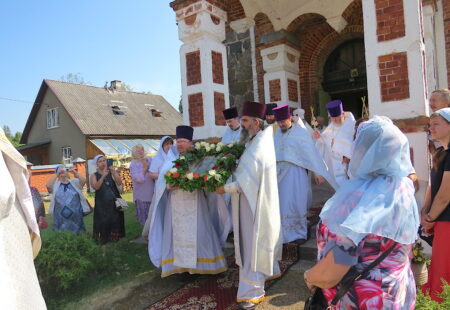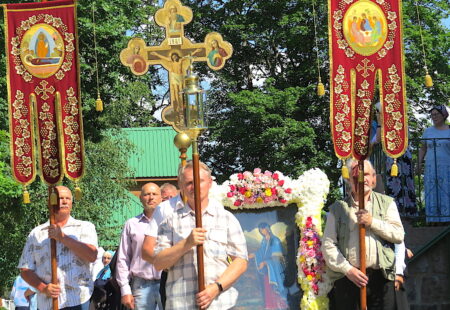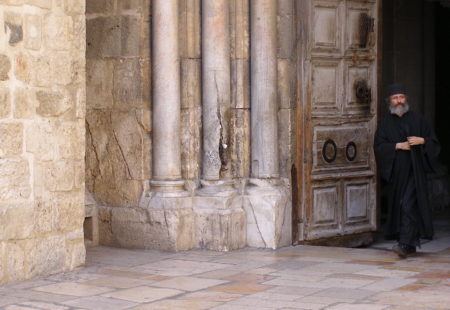Russia Holy Dormition Pskov-Pechersk Monastery August 24, 2019
To view the photos, click on the photo and you can zoom in using the wheel or fingers on your mobile phone. Also note that under the photo there is an interface for a slideshow (the play button in the middle) and arrows for navigating through photos.
Description
The monastery in the twentieth century and today
In the twentieth century, the monastery together with the Fatherland had to go through two wars. But the ancient traditions, carefully preserved in the monastery, were not violated even in the most terrible times for Russian monasticism. By the prayers of the Most Pure Mother of God, the Pskov-Pechersk Monastery was assigned to bourgeois Estonia by the providence of God under the 1922 treaty and remained there until 1940, which saved it from general ruin and desecration.
The disasters that befell our Fatherland during the Great Patriotic War did not pass by the monastery. The Refectory and the Fraternal Building, the wall of the St. Michael’s Cathedral were destroyed. Other churches were also hit by artillery fire.
Archimandrite Pimen, the vicar of the monastery from 1949 to 1954, who later became the Patriarch of Moscow and All Russia, was largely responsible for putting the monastery’s economy in order in the post-war years. His work was continued by Archimandrite Alipius, a warrior and artist (1959-1975). In 1960, he began the restoration of the fortress walls and towers (they had been standing uncovered since 1688 after a devastating fire, gradually collapsing).
During the difficult time of the war, the monastery was headed by Abbot Paul (Gorshkov). After the release of Pechora, he was arrested, sentenced to 15 years and died in a prison hospital at the age of 80. For many years, tourists who visited the monastery were told about its alleged cooperation with the Nazis. Only after 52 years, Abbot Paul was rehabilitated. Then, in the first year of the war, the brethren did not accidentally choose him as their governor. Thanks to the subtle and clever line of behavior he chose with the occupation regime, the monastery with all its values and shrines was preserved, the brethren were preserved. Moreover, trusting in the mercy of God, he strengthened others with his faith, organized food aid to prisoners of the Red Army in the camp point No. 134 of Pskov, the sick and elderly of the Pskov Home for the Disabled and the poorhouse on Zavelichye. There is also evidence that during the war, Soviet scouts took refuge in the monastery caves. One of them, when visiting the monastery in 1984, personally confirmed this fact.
So the holy monastery-fortress and in the last war remained an unquenchable lamp of the Orthodox faith, a reliable support for our compatriots to survive in this difficult time for the whole country.
The monastery was also famous in peaceful years for the spiritual exploits of its inhabitants, whose prayers do not impoverish the mercy of God to those who seek Heavenly consolation at the Pechersk shrines. Throughout the entire existence of the monastery, the fire of senile service has not been extinguished in it. All those who came for spiritual comfort and advice found them in conversations with the great prayer books.
During a visit to the Pechersk Monastery by the family of Tsar Nicholas II, the latter had a spiritual conversation with the elder Theodosius, who was then working in the monastery.
For more than 60 years, Hieroschemimonk Simeon (Zhelnin) served God and people, spiritually nurturing not only the monastery’s brethren, but also numerous laypeople and pilgrims who came to him for spiritual advice. A separate book has been published about his life, in which the reader will find many testimonies about the miraculous prayerful help of the elder. On April 1, 2003, Hieroschemimonk Simeon was glorified in the face of saints.
Schiarchimandrites Agapiy (Agapov), Pimen (Gavrilenko) continued the feat of senile service in the 60s and 70s.
After the Great Patriotic War, the Pskov-Pechersk Monastery was visited by the elders from Valaam, who had been transported from the holy island to Finland before the war. Hieroschemonachs Michael (Pitkevich), Luke (3emskov) and other elders were like a spiritual bridge connecting the Old Valaam and the holy Pechersk monastery. Metropolitan Veniamin (Fedchenkov) spent the last years of his life in the monastery.
The monastery continues to be decorated all these years. In the 80s, with the blessing of Metropolitan John (Razumov), the vicar Archimandrite Gabriel (Steblyuchenko 1975-1988), now Archbishop of Blagoveshchensk and Tynda, carried out major restoration work: the painting of the temple walls was updated, the restoration of the monastery walls, which was started under Archimandrite Alipia, was completed, a new fraternal building was built, a chapel in honor of the Monk-Martyr Cornelius was built in the St. Nicholas Church, the premises were renovated bakeries and libraries.
Thanks to the zeal of the next abbot (1988-1992), Archimandrite Pavel (Ponomarev), now Metropolitan of Ryazan and Mikhailovsky, the monastery’s library, which was kept in Tartu, was returned to the monastery, new buildings of the hospital, icon-restoration and sewing workshops were built, a Mercy House for lonely elderly people was built in the city, 100 hectares of arable land were returned to the monastery.
The viceroy, Archimandrite Roman (Zherebtsov), continued the reconstruction of the monastery buildings and churches, and under his care built a wooden fraternal building and began covering the fortress walls and towers with copper.
The vicar of the monastery from 1995 to 2018, Archimandrite Tikhon (Secretarev) He continued the pious tradition of his predecessors in preserving the monastic charter and improving and decorating the monastery. The construction of the fraternal stone building near the tower of the Lower Lattices with a bath and laundry has been completed, the work on covering the fortress walls with copper has been completed, the construction of the economic complex is underway, the domes of the temples, the paintings on the facade of the Assumption Church have been restored, and the restoration of the Mikhailovsky Church has been carried out.
Its centuries-old traditions are carefully preserved in the monastery. With the blessing of His Holiness, His Holiness Patriarch Alexy II of Moscow and All Russia, the locally venerable Fathers Mark, Jonah, and the Venerable Mother Vassa were added to the All-Russian Holy Places. Since 1994, the monastery has been celebrating the memory of the Holy Fathers of Pskov-Pechersk in the 4th week after Pentecost, and in 1998, the celebration in honor of the miraculous icon of the Mother of God “Emotion”, performed in the 7th week after Easter, was restored. For the first time in many years (since the beginning of the twentieth century) in July 2000, the miraculous icon of the Mother of God ” Tenderness” Pskov-Pecherskaya visited Pskov at the consecration of the chapel in honor of St. Olga.
The monastery continues its catechetical and publishing activities.
On the shore of Lake Pskov, the monastery opened a Priozerny Skete. Also in the monastery there is a skete on the shore of Lake Malsky.
On June 1, 2012, a Pilgrimage center was opened on the territory of the former military unit, which can accommodate a large number of people who want to pray in the monastery and worship its shrines. A guided tour service is also available.
All the spiritual and educational activities of the monastery are led by His Eminence Tikhon, Metropolitan of Pskov and Porkhov, Holy Archimandrite of the Holy Dormition Pskov-Pechersk Monastery with the Spiritual Cathedral, blessing and sanctifying the works of the monks.
And may God grant that, through the intercession of the Most Pure Theotokos, the tradition of the Pechersk asceticism may not be suppressed, and that the monastery may continue to be the bright embodiment of the ideal of Orthodox Holy Russia.













